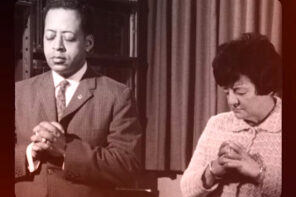Forget the Mormons. Forget Pentecostalism. Hell, forget the Rastafarians. The most fascinating subgroup on the religious landscape at the moment is… soccer fanatics. Catholics are upset about a recent Hyundi commercial that focuses on The Church of the Maradona in Argentina, named for their revered football star (the video has been pulled); a recent, heartfelt post in the Washington Post’s online “On Faith” section compared the inspired leadership of soccer and religion in glowing terms; in a recent USA Today post on the intersections of religion and soccer, the reader is left with the seemingly outrageous question: which ranks higher for you, soccer or religion?; and in our own recent feature, Preston Davis asserts that soccer, like religion, “possesses a beauty that humanizes.”
Recent debates swirling around religion in contemporary culture—science vs. religion; atheists vs. believers; false religion vs. true religion—are silly, ultimately maddening exercises in futility and absurdity. This is the twenty-first century, not the eighteenth, for God’s sake. You would think our society would have evolved to a new level of consciousness about these matters instead of recycling the endless worn-out arguments we’ve heard over and over. Isn’t there anything new under the sun, some fresher perspectives from which to view the religious situation of our world today? Can we take the religion of soccer seriously without having to prepare for the inevitable fire-and-brimstone sermons about glorifying idols or the anti-religious tirades of secular humanists seeking psychological explanations for misplaced passions?
Sadly, public intellectuals, political orators, and polite preachers remain trapped in the same old patterns of thought that seek to divide the world into black and white, true and false, right and wrong, without paying sufficient attention to how muddled reality—and what counts as sacred—is for most of us. And, even more frightening to some, is that God really is irrelevant in the religious equation for a growing number of people. An atheist soccer fan can be religious, just as an evangelical Protestant soccer fan can be religious in more ways than one.
Religion is damn elusive, it isn’t for the faint of heart, and it is definitely not all it’s cracked up to be. All the yammering about “spiritual not religious” begs the question of whether the sacred is really real (as one of my teachers used to say) or just a figment of the imagination, whether found in a sacred text, a towering institution, or on a… (wait for it)… soccer field. So who’s got the scorecard, the measuring stick, the scientific instrument to pinpoint and demarcate what counts as religion versus what is beyond the pale. Where to draw the line between delusional fanaticism and sanctimonious devotionalism?
Ironically, just as the religion beat has been ground down in the current collapse of mainstream media outlets, the media is clamoring for more ways to “cover” religion on blogs (see new CNN’s Belief Blog or the Huffington Post’s Religion section), on cable (a favorite topic for Bill Maher, for example), on Web sites (Beliefnet, even if it is for sale), and so on. But what is being covered is not simply religion, conventionally understood—Jews are doing this, Buddhists are doing that—nor is it only spirituality vaguely conceptualized—New Agers with crystals, meditation retreats for the professional class. Instead, both old and new media have lit up the religious landscape, illuminating what is still an unconventional, and nebulous, but certainly increasingly capacious, understanding of the sacred in everyday life. Rock and roll can be religious, according to The Hold Steady; a recent Los Angeles Times article explores how celebrity doctors blur the lines between faith and obsession; and in a recent RD interview, a pilgrimage to the desert can be alive with religious possibilities.
The unvarnished truth is that when it comes to religion, the rules of the media game have changed dramatically in the last decade—assuming that there are, in fact, any rules left to change. Up until very recently “religion” had a very limited conceptual range in public media: the pesky evangelicals in politics; the demanding conservative Catholics on reproduction; the persistence of Jewish support for the Democratic party. The culturally dominant Christian and Jewish and, dare I say, narrow-minded perspective on religion and religious identity determined the rules of the game when representing religious life, and what is “mainstream” and what is “alternative,” throughout most of the twentieth century.
Those days are over. Yes, a slew of social changes have made an impact on these rules—9/11, patterns of immigration, the Internet—and opened the door for much greater attention to religious diversity and the realities of living with Muslims and Buddhists, Wiccans and Sikhs. But to bring us back to soccer, equally important as this newfound interest in religions outside of the Jewish and Christian faiths, is the media’s willingness to entertain religion in increasingly broad and non-monotheistic terms. The current media terrain also makes religion much more entertaining than dogma and doctrine, pulpits and God.
Who are the new arbiters of what counts as “real” religion, and what doesn’t? Where are the lines of authority in this new media landscape when it comes to framing stories for the public? Why take soccer seriously as a religious phenomenon? The rules of the game are changing as the media landscape transforms, which should make for a wild and wooly time in the coming decade.




